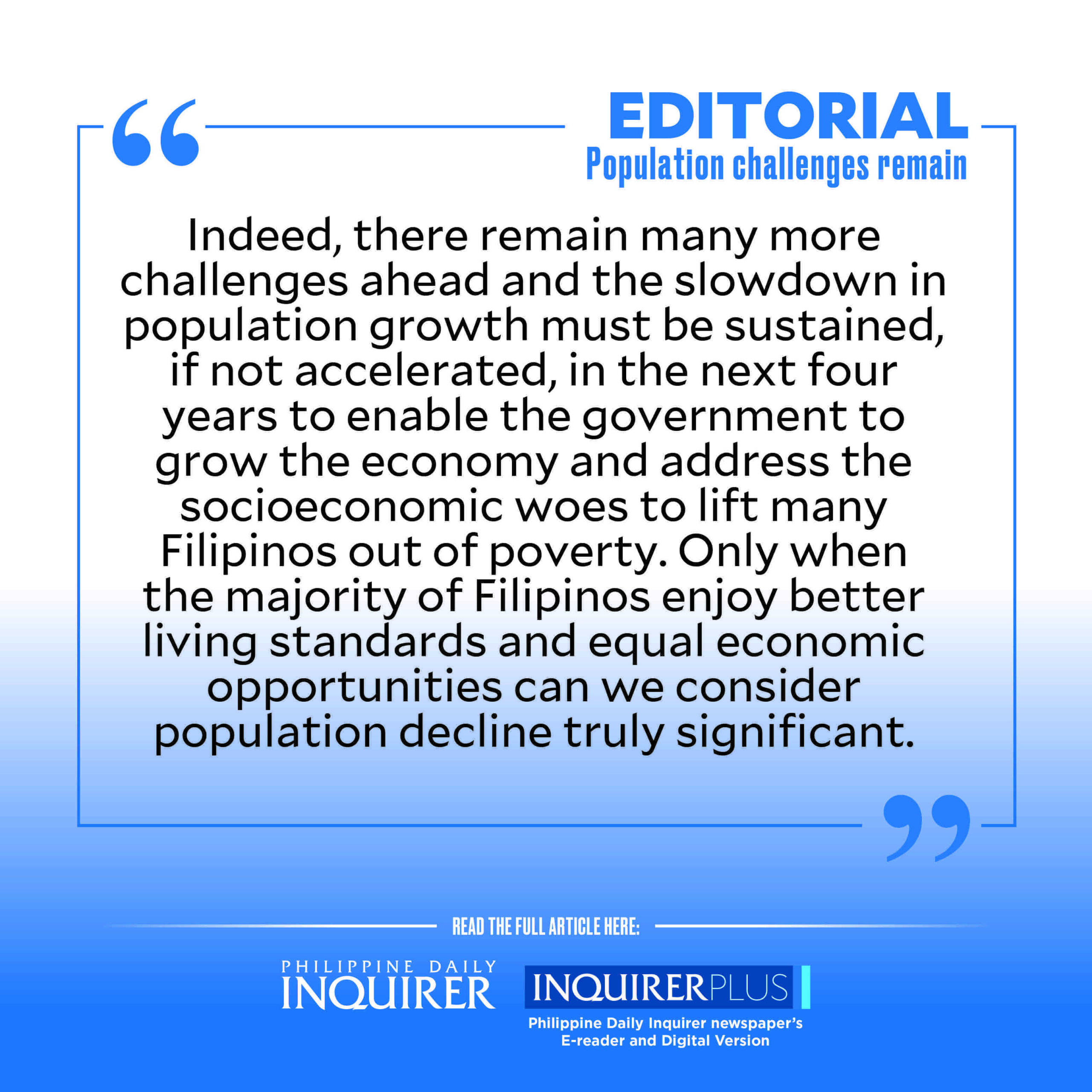Population challenges remain

Slowing down population growth seemed unattainable more than a decade ago when the Philippines was considered one of Asia’s fastest-growing populations. Recent statistics show, however, a considerable decline in the population growth rate attributed to Filipinos preferring smaller families, even delaying having children, due to dire economic conditions.
A study by the Philippine Statistical Research and Training Institute for the Commission on Population and Development (CPD) cited the economic uncertainties brought by the COVID-19 pandemic and inflationary prices of basic goods and services as reasons why Filipino couples are not keen on having children. The slow population growth could also be attributed to increased awareness, especially among women, of their reproductive rights following the enactment of Republic Act No. 10354 or the Responsible Parenthood and Reproductive Health Act of 2012, which, among others, ensures the accessibility of family planning methods including condoms and birth control pills.
Demographic patterns
In 2020, when the COVID pandemic was declared, total registered live births declined 8.68 percent year-on-year to 1.53 million and fell further by 10.72 percent in 2021 to 1.36 million. CPD cautioned back then that the slow population growth was a “variation” in the normal demographic patterns due to the pandemic and could go up again once restrictions were lifted. True enough, the numbers rebounded in 2022 with a 6.64 percent increase to 1.46 million live births.
While this rise is not alarming because the country’s fertility rate of 1.9 in 2022 is still within the ideal 2.1 children per woman to maintain stable population size, the Philippines remains the second most populous among member countries of the Association of Southeast Asian Nations and is also ranked 13th most populous globally. The government must continue monitoring the population growth rate and even accelerate the slowdown because, per the Philippine Population and Development Plan of Action 2023-2028, which serves as the Marcos administration’s overall blueprint for addressing population and development issues, other population challenges have to be dealt with and there are only four years to work on them.
Unequal population distribution
Among these is the unequal population distribution across regions resulting in unequal regional development. Two in five Filipinos, based on the 2020 Census of Population and Housing, live in the National Capital Region, Central Luzon, and Calabarzon because these are where most industries are located and, therefore, where the job opportunities are also concentrated. Developing urban centers outside these three megaregions will not only ease population density and other problems like traffic but also spread infrastructure development and economic benefits to the countryside. Giving more Filipinos better job opportunities can lead to a better quality of life where they can provide for their housing, health, and education needs, and pass on these benefits and opportunities to their children.
For now, however, this remains a pipe dream with poverty remaining prevalent, and stunting—another population challenge—affecting about a third of the under-five population because parents are unable to provide proper nutrition and health care. Stunting is caused by malnutrition and is largely irreversible: stunted children are sickly, and because of poor health, are likely to miss school and suffer chronic diseases later on in life. And, because they do not attain proper education, they will not be qualified to join the workforce, and it will even be harder for them to get out of poverty.
Problem of stunting
The problem of stunting among Filipino children is further compounded by another challenge: the dismal state of our education system. A World Bank and Unesco report said nine out of 10 10-year-old Filipino students cannot read or understand a short age-appropriate text. If our schools continue to produce students who are unable to read, future generations won’t acquire the skills required by various industries that could drive economic growth and development. This spells disaster and will only continue to make life even harder especially for poor Filipinos.Indeed, there remain many more challenges ahead and the slowdown in population growth must be sustained, if not accelerated, in the next four years to enable the government to grow the economy and address the socioeconomic woes to lift many Filipinos out of poverty. Only when the majority of Filipinos enjoy better living standards and equal economic opportunities can we consider population decline truly significant.
















